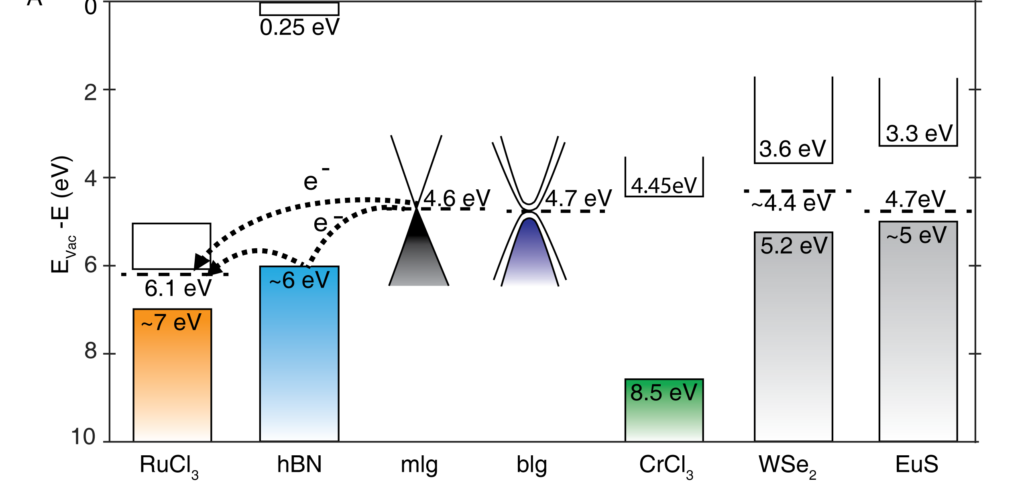Emergent Phases and Novel Heterostructures
Our group is interested in understanding the emergence of novel states of matter. We focus on heterostructures and novel device geometries to create, understand, and manipulate these states and their excitations.
Higher-Order Topology
Topological phases of matter, those defined by an invariant in Hilbert space, are quite challenging to identify and probe. This results from their defining characteristic, a property that is non-local in phase space and cannot be changed adiabatically. There are now numerous examples of such topological phases of matter, revealed via novel boundary modes or resulting fractional excitations. Indeed, the bulk-boundary correspondence is typically understood to suggest a topological phase in D dimensions will result in states in the D-1 dimensions that are not possible solely in their intrinsic dimension with the same symmetries. Recently, a new class of topological systems has emerged, higher-order (n>1) Topological states, whose bulk-boundary correspondence is more complex producing states (hinge or corner modes) in D-n dimensions (see Figure above). These can be thought of as topological systems whose boundary states are gapped, and are themselves topological systems, resulting in new modes at the domains between these topological boundaries. A particularly promising system is the Fe-chalcogenides (FeSeTe) where the combination of s± order and topology could lead to higher-order topological superconducting state. Our group was the first to provide evidence for hinge modes in this system through proper device design and is working to better understand their properties. We are also exploring how the topological properties manifest themselves in other optical measurements.
2D crystalline acceptor and Relativistic Mott Insulator RuCl3
Relativistic Mott insulators result from the combination of electron repulsion and strong spin-orbit coupling. Our group was the first to demonstrate this leads to fractional magnetic excitations in the van der Waals material RuCl3. Recently it was discovered that the deep work function of RuCl3 enables strong charge-transfer in 2D heterostructures. We are investigating the optimal conditions for this effect and how to exploit it to realize a wide variety of novel correlated states and optoelectronic devices.
New Device Architectures

Our group has recently developed a Cleanroom in a Glovebox where all stages of fabrication can be performed. We using this to develop new techniques to exfoliate on thin-films. This allows a wide array of combinations of topological, superconducting, and magnetic materials to be combined, as well as device architectures. In addition, through careful choice of substrate and top gate (e.g graphene), we can tune the chemical potential, modify the material with light and probe using tunneling, Infrared, and Raman.
Proximity-Induced high Tc Superconductivity in Topological Insulators
 Interest in the superconducting proximity effect has been reinvigorated recently by novel optoelectronic applications as well as by the possible emergence of the elusive Majorana fermion at the interface between topological insulators and superconductors. Towards these goals, our group built upon our success exfoliating high-temperature superconductors and topological insulators to develop an entirely new method to generate the superconducting proximity effect. We produced high-temperature superconductivity in Bi2Se3 and Bi2Te3 via proximity to Bi-2212. This enabled us to access higher temperatures and energy scales for the superconducting proximity effect than ever previously observed in any semiconductor (let alone a topological insulator). This work has been expanded to reveal a proximity effect in graphite, the Doppler effect confirming Andreev reflection, and Modeling tunneling for the unconventional superconducting proximity effect. On-going efforts are aimed at expanding to new superconductors and topological materials.
Interest in the superconducting proximity effect has been reinvigorated recently by novel optoelectronic applications as well as by the possible emergence of the elusive Majorana fermion at the interface between topological insulators and superconductors. Towards these goals, our group built upon our success exfoliating high-temperature superconductors and topological insulators to develop an entirely new method to generate the superconducting proximity effect. We produced high-temperature superconductivity in Bi2Se3 and Bi2Te3 via proximity to Bi-2212. This enabled us to access higher temperatures and energy scales for the superconducting proximity effect than ever previously observed in any semiconductor (let alone a topological insulator). This work has been expanded to reveal a proximity effect in graphite, the Doppler effect confirming Andreev reflection, and Modeling tunneling for the unconventional superconducting proximity effect. On-going efforts are aimed at expanding to new superconductors and topological materials.
- “Physicists induce high-temperature superconductivity in semiconductor with Scotch tape” phys.org, Sept. 11th 2012
- “Quantum Computer Not Working? Grab Some Scotch Tape” Wired, Sept. 18th, 2012
- “Scotch Tape Aids Superconductivity Breakthrough” Toronto Star, Sept. 13th, 2012
- “Scotch Tape May Stick Quantum Computing to the Masses” NBC News, Sept. 11th, 2012
- “Scotch Tape Used For Developing Quantum Computers” French Tribune, Sept. 13th, 2012
- “Scotch Tape Even Makes Semiconductors Better” Gizmodo, Sept. 16th, 2012



